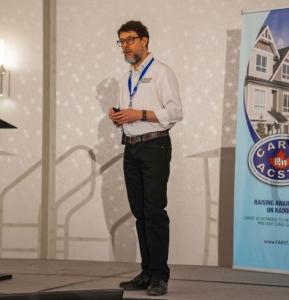The History of Radon Dose Conversion Factor Highlights the Need for Continued Progress
Assessing on the job radon exposure in individuals has evolved over the years as presented at the 13th Annual CARST Radon Conference in Canada
LOMBARD, IL, UNITED STATES, May 6, 2024 /EINPresswire.com/ -- It is well known that the effects of radon gas is harmful to humans. Radon exposure is a leading cause of lung cancer, second only to smoking. Measuring the amount of radon in a home or workplace can be done with a radon detector. However, a separate calculation is needed to determine the specific risk to individuals from the radon they are exposed to in their home or workplace.Dr. Jose-Luis Gutierrez Villanueva, a Radon Specialist Advisor with Radonova Laboratories and Secretary of the European Radon Association, presented the history of radon dose conversion factors at the recent Canadian Association of Radon Scientists and Technologists (CARST) Annual Conference in Moncton, New Brunswick. This 13th annual event featured researchers and scientists from the public, private, and academic sectors who presented educational sessions on radon measurement, radon mitigation, radon awareness initiatives, and radon exposure risks for lung cancer.
Dr. Villanueva’s presentation discussed how assessing occupational/workplace radon exposure in individuals has evolved over the years. In the past and in the present, the goal has always been to establish recommendations for how to best measure radon that workers are exposed to on the job, how to establish upper limits of acceptable exposure, and how to create national and international reference levels.
What is dose level for radon?
The “dose” a person receives from the presence of radon gas is derived from the energy emitted from its radioactive decay products. To determine the amount of radon exposure people are exposed to in the workplace, a dose calculation is used to describe the hazard associated with radon.
Different approaches to measuring radon dose
Dr. Villanueva explained that the evaluation of the radon dose is a mathematical calculation that considers, among other parameters, the radon concentration and a factor that converts concentration into dose.
The dosimetric approach takes into account dose estimations, atmospheric conditions, breathing characteristics, and lung modelling. The epidemiological approach considers the risk of lung cancer per unit of radon exposure using historical measurements collected from mine workers and other epidemiological studies with the general public. There can be discrepancies between the two approaches which can contribute to inconsistencies for reporting radon dose per person.
How the radon dose conversion factor has evolved
Throughout the years, the approach to determining radon dose conversion factors has evolved in the Annals of International Commission of Radiological Protection (ICRP). The International Commission on Radiological Protection (ICRP) makes recommendations for protecting people against radon exposure at home and at work.
Dr. Villanueva presented changes that have taken place since 1977 with additional examples from 1997, 2010, and 2014 Annals of the ICRP.
Dr. Villanueva concluded his presentation with an explanation of the 2017 ICRP Annals, entitled “Occupational Intakes of Nuclides: Part 3”, which suggests using a standard DCF (dose conversion factor ) and an equilibrium factor (F) of 0.4 in most of the situations. Most European countries are following the ICRP recommendations. To help minimize public risk of radon exposure, providing a standard to evaluate individual radon exposure effects in a way that can be adopted across countries and regions will help protect the public. “Communicating radon levels and radon dose to the public in ways that can be easily understood remains a goal. There aren’t firm answers yet, but this is a conversation we should continue to have,” concluded Dr. Villanueva.
About Radonova
Radonova is the laboratory of choice for numerous large-scale radon measurement projects around the world. A truly global laboratory, Radonova is active in over 80 countries and has performed millions of measurements.
Zan Jones
Radonova
email us here
+1 331-814-2200
Visit us on social media:
Facebook
Twitter
LinkedIn
YouTube
Legal Disclaimer:
EIN Presswire provides this news content "as is" without warranty of any kind. We do not accept any responsibility or liability for the accuracy, content, images, videos, licenses, completeness, legality, or reliability of the information contained in this article. If you have any complaints or copyright issues related to this article, kindly contact the author above.


